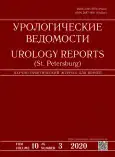Заместительная уретропластика тканеинженерными конструкциями в эксперименте
- Авторы: Горелова А.А.1,2, Муравьев А.Н.1,3, Виноградова Т.И.1, Горелов А.И.2,4, Юдинцева Н.М.5, Нащекина Ю.А.5, Самусенко И.А.6, Яблонский П.К.1,2
-
Учреждения:
- Федеральное государственное бюджетное учреждение «Санкт-Петербургский научно-исследовательский институт фтизиопульмонологии» Министерства здравоохранения Российской Федерации
- Федеральное государственное бюджетное образовательное учреждение высшего образования «Санкт-Петербургский государственный университет»
- Частное образовательное учреждение высшего образования «Санкт-Петербургский медико-социальный институт»
- Санкт-Петербургское государственное бюджетное учреждение здравоохранения «Городская Покровская больница»
- Федеральное государственное бюджетное учреждение науки Институт цитологии Российской академии наук
- Федеральное государственное бюджетное учреждение «Всероссийский центр экстренной и радиационной медицины им. А.М. Никифорова» Министерства Российской Федерации по делам гражданской обороны, чрезвычайным ситуациям и ликвидации последствий стихийных бедствий
- Выпуск: Том 10, № 3 (2020)
- Страницы: 201-208
- Раздел: Оригинальные статьи
- URL: https://journals.rcsi.science/uroved/article/view/46031
- DOI: https://doi.org/10.17816/uroved46031
- ID: 46031
Цитировать
Аннотация
Актуальность. Для исключения сложностей, возникающих в ходе традиционных оперативных вмешательств в объеме заместительной уретропластики, в последние годы разрабатываются альтернативные материалы с использованием тканевой инженерии. Данное исследование посвящено разработке новых тканеинженерных конструкций для пластики уретры с использованием клеток различного тканевого происхождения и биополимеров, что является актуальной проблемой современной медицины.
Цель. Экспериментальное обоснование возможности применения тканеинженерных конструкций для замещения дефектов уретры.
Материалы и методы. Исследование двухэтапное, экспериментальное, контролируемое. Посвящено разработке тканеинженерных конструкций (ТИК) на основе биополимеров, заселенных мезенхимальными стволовыми клетками или клетками буккального эпителия. Приготовленные ТИК имплантировали в уретру кролика на модели ее острой травмы. Проведено сравнение результатов применения ТИК с золотым стандартом — буккальной пластикой.
Результаты. При уретрографии получены схожие результаты у всех групп животных, независимо от типа имплантированного материала. Нарушений проходимости уретры выявлено не было, а при конфокальной микроскопии криосрезов уретры обнаружено присутствие в слизистом слое меченных наночастицами мезенхимальных стволовых клеток / клеток буккального эпителия с признаками их дифференцировки в уротелиальном направлении.
Заключение. Показана возможность использования для заместительной уретропластики в экспериментальных условиях тканеинженерных конструкций на основе биополимеров, содержащих аутологичные мезенхимальные стволовые клетки или клетки буккального эпителия. Разработанные ТИК можно использовать в качестве альтернативы буккальной уретропластике в эксперименте.
Ключевые слова
Полный текст
Открыть статью на сайте журналаОб авторах
Анна Андреевна Горелова
Федеральное государственное бюджетное учреждение «Санкт-Петербургский научно-исследовательский институт фтизиопульмонологии» Министерства здравоохранения Российской Федерации; Федеральное государственное бюджетное образовательное учреждение высшего образования «Санкт-Петербургский государственный университет»
Автор, ответственный за переписку.
Email: gorelovauro@gmail.com
ORCID iD: 0000-0002-7010-7562
аспирант; ассистент кафедры госпитальной хирургии
Россия, Санкт-ПетербургАлександр Николаевич Муравьев
Федеральное государственное бюджетное учреждение «Санкт-Петербургский научно-исследовательский институт фтизиопульмонологии» Министерства здравоохранения Российской Федерации; Частное образовательное учреждение высшего образования «Санкт-Петербургский медико-социальный институт»
Email: urolog5@gmail.com
ORCID iD: 0000-0002-6974-5305
канд. мед. наук, руководитель направления «Урология, гинекология и абдоминальная хирургия»; доцент кафедры хирургических болезней
Россия, Санкт-ПетербургТатьяна Ивановна Виноградова
Федеральное государственное бюджетное учреждение «Санкт-Петербургский научно-исследовательский институт фтизиопульмонологии» Министерства здравоохранения Российской Федерации
Email: vinogradova@spbniif.ru
ORCID iD: 0000-0002-5234-349X
д-р мед. наук, профессор, главный научный сотрудник
Россия, Санкт-ПетербургАндрей Игоревич Горелов
Федеральное государственное бюджетное образовательное учреждение высшего образования «Санкт-Петербургский государственный университет»; Санкт-Петербургское государственное бюджетное учреждение здравоохранения «Городская Покровская больница»
Email: gorelov_a_i@mail.ru
ORCID iD: 0000-0002-2858-5317
д-р мед. наук, профессор кафедры госпитальной хирургии; заведующий отделением урологии
Россия, Санкт-ПетербургНаталия Михайловна Юдинцева
Федеральное государственное бюджетное учреждение науки Институт цитологии Российской академии наук
Email: yudintceva@mail.ru
ORCID iD: 0000-0002-7357-1571
канд. биол. наук, старший научный сотрудник
Россия, Санкт-ПетербургЮлия Александровна Нащекина
Федеральное государственное бюджетное учреждение науки Институт цитологии Российской академии наук
Email: ulychka@mail.ru
ORCID iD: 0000-0002-4371-7445
канд. биол. наук, научный сотрудник
Россия, Санкт-ПетербургИгорь Алексеевич Самусенко
Федеральное государственное бюджетное учреждение «Всероссийский центр экстренной и радиационной медицины им. А.М. Никифорова» Министерства Российской Федерации по делам гражданской обороны, чрезвычайным ситуациям и ликвидации последствий стихийных бедствий
Email: egors_2000@mail.ru
ORCID iD: 0000-0003-0622-3515
канд. мед. наук, врач-патологоанатом
Россия, Санкт-ПетербургПетр Казимирович Яблонский
Федеральное государственное бюджетное учреждение «Санкт-Петербургский научно-исследовательский институт фтизиопульмонологии» Министерства здравоохранения Российской Федерации; Федеральное государственное бюджетное образовательное учреждение высшего образования «Санкт-Петербургский государственный университет»
Email: glhirurgb2@mail.ru
ORCID iD: 0000-0003-4385-9643
д-р мед. наук, профессор, директор; заведующий кафедрой госпитальной хирургии
Россия, Санкт-ПетербургСписок литературы
- Аль-Шукри С.Х., Невирович Е.С., Перекалин П.В., и др. Заместительная уретропластика свободными лоскутами слизистой оболочки щеки при протяженных стриктурах передней уретры // Урологические ведомости. – 2012. – Т. 2. – № 2. – С. 48–51. [Al-Shukri SKh, Nevirovich ES, Perekalin PV, et al. Substitute urethroplasty using free oral mucosa grafts in treatment of long strictures of anterior urethra. Urologicheskie vedomosti. 2012;2(2): 48-51. (In Russ.)] https://doi.org/10.17816/uroved2248-51.
- Barbagli G, Kulkarni SB, Fossati N, et al. Long-term followup and deterioration rate of anterior substitution urethroplasty. J Urol. 2014;192(3):808-13. https://doi.org/10.1016/j.juro.2014.02.038.
- Cheng L, Li S, Wang Z, et al. A brief review on anterior urethral strictures. Asian J Urol. 2018;5(2):88-93. https://doi.org/10.1016/j.ajur.2017.12.005.
- Versteegden LRM, de Jonge PKJD, IntHout J, et al. Tissue Engineering of the Urethra: A Systematic Review and Meta-analysis of Preclinical and Clinical Studies. Eur Urol. 2017;72(4):594-606. https://doi.org/10.1016/j.eururo.2017.03.026.
- Муравьев А.Н., Орлова Н.В., Блинова М.И., Юдинцева Н.М. Тканевая инженерия в урологии, новые возможности для реконструкции мочевого пузыря // Цитология. – 2015. – Т. 57. – № 1. – С. 14–18. [Murav’ev AN, Orlova NV, Blinova MI, Yudintseva NM. Tissue engineering in urology, new approaches for urinary bladder reconstruction. Cell and tissue biology. 2015;57(1):14-18. (In Russ.)]
- Yudintceva NM, Nashchekina YA, Blinova MI, et al. Experimental bladder regeneration using a poly-l-lactide/silk fibroin scaffold seeded with nanoparticle-labeled allogenic bone marrow stromal cells. Int J Nanomedicine. 2016;11:4521-4533. https://doi.org/10.2147/IJN.S111656.
- Feng C, Xu YM, Fu Q, et al. Evaluation of the biocompatibility and mechanical properties of naturally derived and synthetic scaffolds for urethral reconstruction. J Biomed Mater Res A. 2010;94(1):317-325. https://doi.org/10.1002/jbm.a.32729.
Дополнительные файлы

























